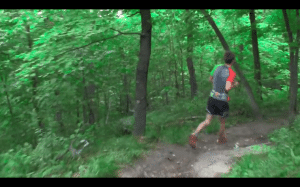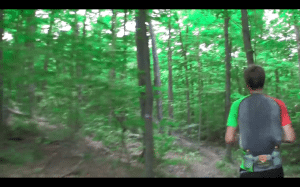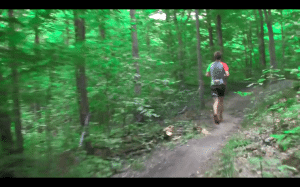By Mimi Sheller
What happens when the virtual and real worlds meet? What effects do virtual representations of mobility have on reality? The first feedback meeting Esther Polak and Ivar van Bekkum organized for the 250 Miles Crossing Philadelphia commission dove into these concepts. Mobility research scholar Mimi Sheller makes some unexpected connections, ultimately showing how “250 Miles Crossing Philadelphia” enhances our understanding of the world around us.



At the Mobility in Virtual Worlds feedback meeting back in July 2014 we looked at some clips of different ways of representing “mobility”: from the very abstract experimental film of Stan Brakhage’s Dog Star Man (link) (which really just gave an impression of movement through rapid cuts), to very mundane treadmill running videos that follow people jogging along outdoor paths (and are watched by people running on treadmills), to the kinds of moves seen in online games where a figure jumps, hops, and walks through a virtual world. These virtual worlds can be more or less realist or fantastical, from Pacman, to Minecraft, to Call of Duty, to Inception. Then we looked at some of Esther and Ivar’s work in Google Earth, like the GPS-Opera ETAK (a kind of sound-track of a drive through virtual space with a navigation system) and their first test of some location-based recorded sound here in Philadelphia (which we had trouble placing, but some guessed from the sound of water lapping and a plane passing that it was near the Delaware at the airport).
These experiences all left very different impressions of what “mobility” means and what “virtual worlds” means. There seems to be many kinds of mobility happening when we try to represent mobility: there is the mobility of the action such as walking, running, or jumping; there is the mobility of the recording device such as the camera, the microphone, or the global positioning satellite; and there is the mobility of the medium holding the representation, such as the film strip, or the “flow” of video, or the data stream. And each kind of mobility makes different impressions on our senses – eyes, ears, touch – which might be more or less “synched”, leaving different sensations. All of the examples used sound in different ways, and made us think about sound recording and how it affects feelings of movement. The recording of the lapping waves of the river brought back to me the sensation of going snorkeling and lifting my ears from the muffled watery under-sea soundscape up to the noisy surface of sound-traveling-through-air.
So what was “virtual” about these representations of mobility? These were all “virtual worlds” in the sense that they were representations of physical worlds: they were not “real” experiences of mobility, but once removed. Something virtual is mediated, but in some sense replicates the feel of the real. Google Earth is perhaps closest to the idea of the “virtual” as a computer-generated space, but video games also have that quality, and in some ways film and video do too: we index them to the world we know and recognize them as a kind of parallel world. In fact we talked about the feeling of being “virtually” mobile amongst cyclists who get together to ride fixed bikes while watching bike racing videos: they feel almost as if they are on the ride, and as they virtually take the corners and swerves they are at risk of tipping off of their fixed bikes! When we actually move our bodies while experiencing virtual mobility (walking on treadmills, riding fixed bikes, or even just listening to music while moving) we can reach a kind of new experience that blends elements of the real and the virtual, suspending us within both at once.
This leads me to think about “real” mobility in “virtual” reality: how does the relation between mobility and virtuality shift if we think about location-based and augmented reality technologies that allow us to project virtual images as we move through actual spaces? For example, location-based projections of architectural features, historical photographs, signs and path markings, or “pop-up” information such as that on some car windshields, or Google Glass, or that can be held up on a tablet using a “situated simulation” (sit-sim). This is a different kind of mobility in virtual worlds, where the movement takes place through an actual bodily mobility, carrying the virtual aspects of representation along with us as a kind of overlay. Of course screens are only one way to have this experience, because many artists have also been doing location-based sound walks for a long time, which bring a “virtual” sonic experience into moving through particular places – see for example the work of Teri Rueb, or Janet Cardiff.
Esther and Ivar’s collaboration with Austin Seraphin reminds me that there is another dimension to this, too, because he uses clicking noises to create a “virtual” representation in his head of the physical space he is moving through; and the map of raised lines that they read together also serves as a virtual device for walking (with the fingers) through a geographic topography. So there are all kinds of virtual mobilities and different ways of sensing and moving through them. We can displace the experience of movement into different media, re-experience it in different situations, and re-mix it with our bodily mobility in different ways. And if artwork can help us think about that and reflect on it, then it has enriched and deepened our sense of being in the world.
-Mimi Sheller



Mimi Sheller is Professor of Sociology and founding Director of the Center for Mobilities Research and Policy at Drexel University.
She is the author of several books and numerous articles in the field of Caribbean Studies. As co-editor, with John Urry, of Mobile Technologies of the City (Routledge, 2006), Tourism Mobilities (Routledge, 2004), and a special issue of the journal Environment and Planning A on ‘Materialities and Mobilities’, she helped to establish the new field of mobilities research.
This article was originally published on the website of 250 Miles Crossing Philadelphia